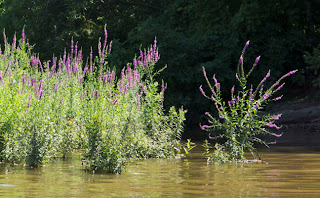Twelve kayaks put in below the dam in Kletsch Park in Glendale. The rain-swollen river pours over the dam like water from a tipped bucket that never empties. Our progress is swift. Without lifting a paddle we can drift and daydream. Welcome to my daydream.
Richard Louv suggests that technology and nature are not incompatible, but “the more high-tech our lives become, the more nature we need to achieve a natural balance.” I’ve left my cell phone behind, but not my camera. To each their own technologies. Balance, too, is up to each of us.
There are few places on earth with an abundance of fresh water. The danger of abundance is a tendency to take the resource for granted; perhaps to fail to protect it. Milwaukee, part of the Great Lakes watershed, is particularly fortunate. Drifting, my mind fills with the grace of abundance.
It is Friday, a workday; lawn chairs poised to enjoy river views sit empty and silent. The day, warm and bright, reminds me of a line from Leonard Cohen’s song, Suzanne: “the sun shone down like honey…”
Canada geese preen themselves on stones near the shore. I slide slowly towards one who nonchalantly continues its regimen of grooming until I am so near I could wack it with my paddle. (Indeed, this species is often considered a pest and others might have been tempted to do so.)
We round a sharp bend to where the river parallels the forbidding barrier along I-43. The tranquility of our idyll is disturbed by the sound of unseen traffic. A famous line comes to mind from Frost’s poem, Mending Wall: “Something there is that doesn't love a wall, that wants it down…”
Serenity returns when the river veers into Lincoln Park. The river divides into two channels around an island. Our guide, Jeanne, cautions us to keep to the right, which only serves to whet my curiosity: what would I find if I go to the left? Had I been alone, I might have tried it, but, conditioned as I am by my years of teaching, I dutifully follow the group.
Purple loosestrife grows rampant on the muddy floodplain exposed when the Estabrook Dam was opened a couple years back. Ironic, perhaps: an invasive species floods in where an invasive dam once held back the water. Something there is that doesn't love a dam, that wants it down…
We drift with the current, under a synchronicity of clouds.
I am stupefied, unable to conjure a clever caption. Robert Michael Pyle asks, “What happens to a species that loses touch with its habitat?”
On the freeway a river of cars, nearly as incessant as water, speeds over the Milwaukee River.
We portage around the dam, the proposed removal of which has generated so much heated debate. Frost’s poem returns to haunt me: neither walls nor dams make good neighbors.
We also portage around the falls in Estabrook Park. Four teenage boys in the flood-swollen river use the dangerous cataract as a waterslide. The cell phone comes in handy. We drift on. We can only hope that the police will arrive before tragedy befalls the foolish.
Buddhism teaches us to be mindful. Mindfulness is not disengagement but its opposite. It is thoughtlessness that allows us to fritter away the earth’s abundance – or to sit idly by and see it frittered away, doing nothing to prevent it.
Below the Capitol Drive bridge we enter my favorite stretch of the Greenway. In the kayak, in the middle of the channel, the last remaining tower slowly disappears behind the tree line. With it goes the feeling of being in the city. My imagination is set completely at ease.
The elusive feeling of wildness resolves itself and I welcome it.
Still adrift, still moving buoyantly forward, I raise my eyes skyward, filled with enchantment.
I have long been inspired by Thoreau’s famous words, “In wildness is the preservation of the world.” I don’t believe it diminishes Thoreau to agree with Mike Houck, director of the Urban Greenspaces Institute in Portland, OR, who updates that for the twenty-first century: “In livable cities is the preservation of the wild.”
After three hours, twelve kayaks pull up on the bank at Riverside Park, below the Urban Ecology Center, which organized our excursion into the urban wilderness.
In a new book called Urban Green, Peter Harnik says “…parks are on the public’s agenda” and “…cities are vying with one another for ‘the best park system’ and the ‘livability crown’….” He mentions New York, Philadelphia, Washington, Seattle, and even Detroit as examples. Why not Milwaukee? Where are Milwaukee’s cheerleaders when it comes to promoting the virtues of our gold medal park system?















WOW... Sooo true....
ReplyDeleteBlessings